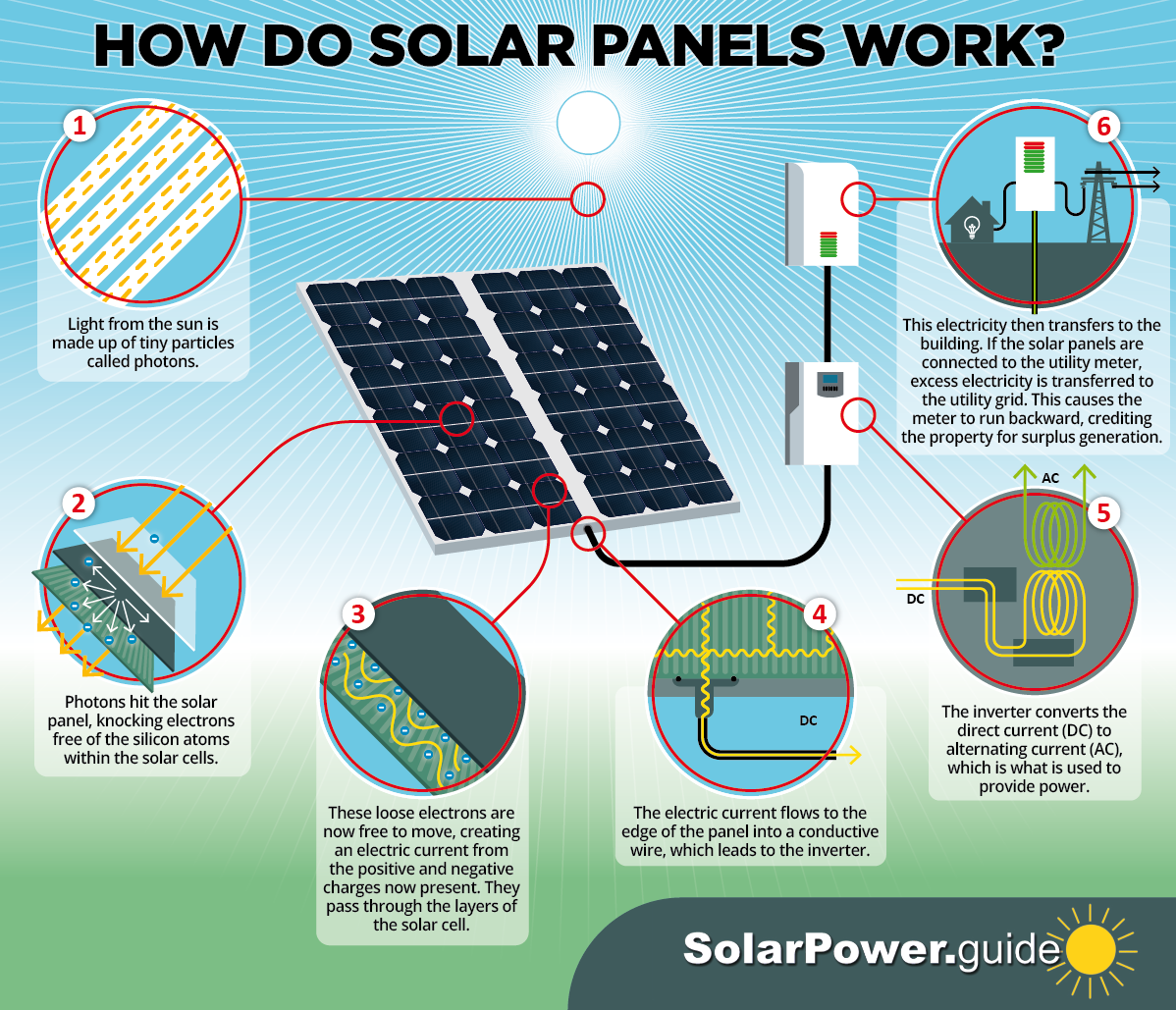How Do Solar Panels Work?
Solar energy systems are developing around the world, but for many, this rapidly growing form of renewable energy raises a question: How does solar energy work? Solar energy has emerged as the cheapest form of energy, and with that comes a lot of curiosity about how solar panels work and how solar energy works. To help shed some light on the topic, here is a simple visual guide from SolarPower.guide to how solar panels work step by step, which will be explored in more detail below.
Click the below image to view full-size.

Simply copy and paste the code from the box below to share.
How Do Solar Panels Work?
The amount of sunlight that reaches Earth’s surface within an hour and a half has enough energy to satisfy the world’s energy consumption for an entire year. That is truly impressive and offers hope for a brighter, more sustainable future. But how does solar power work? Here is a step-by-step breakdown of solar energy, how it works, and additional resources:
- When it comes to solar panels, how they work relies on a tiny component called a photovoltaic cell. These cells are typically constructed from silicon. When the sun shines on a solar panel, the photons are absorbed by the silicon cells.
- The photons of sunlight knock electrons out of the silicon atoms, which are now free to move. They travel through the layers of the cell, creating an electrical current.
- The electric current flows to the edge of the panel, funneling into a conductive wire. This wire delivers the electricity to the inverter, which converts the direct current (DC) energy into alternating current (AC) energy, which is what is used to power buildings.
- This electricity then transfers to the building. If the solar panels are connected to the utility meter, excess electricity is transferred to the utility grid. This causes the meter to run backward, crediting the property for surplus generation.
So if a child ever asks you, “How does solar energy work?” a simple, short explanation is that solar panels are filled with solar cells that harvest light from the sun. These cells contain materials that have the ability to turn energy from sunlight into electricity, much like how chloroplasts in plants gather sunlight and turn it into fuel.
For additional information on how solar energy works, check out these solar energy resources:
- How Does Solar Work? — U.S. Office of Energy Efficiency and Renewable Energy
- Solar Photovoltaic Technology Basics — U.S. Office of Energy Efficiency and Renewable Energy
- How Do Solar Panels Work? — LiveScience
How Do Solar Cells Work?
Solar panel cells are referred to as photovoltaic cells. “Photovoltaic” simply means that they convert sunlight into electricity. Many of these small cells link together to form a solar panel. These tiny cells are the key to how solar energy works.
Each individual photovoltaic cell is essentially a sandwich composed of two segments of semi-conducting material, typically silicon. These “silicon sandwich slices” are prepared with materials that give each one a positive or negative charge. Specifically, the top layer of silicon is prepped with phosphorus, which adds extra electrons. The bottom layer is dosed with boron, which results in fewer electrons, creating a positive charge. This creates the ideal space for atoms to flow through, similar to how batteries function.
When photons from sunlight hit the solar panel, they knock electrons free. These electrons flow toward the negatively charged layer of the solar cell, creating an electrical current. Metal conductive plates on the sides of the solar cells collect the electrons and transfer them to wires. It is truly a marvel how these tiny cells, which are often no thicker than a few strands of hair, are a crucial part of how solar panels work.
How Do Solar Panels Work on a House?
Solar panels are typically placed on the roof of a home facing in the direction that receives the most sunlight. The solar panels collect photons from sunlight and use them to generate a direct current. This flows to the inverter, which is generally on the side of your home. The inverter converts the electricity to alternating current, which is what is used to power homes and businesses. This current travels from the inverter to the electric panel (also on the side of the home), which then delivers electricity throughout the house. If the solar power system is connected to the electrical grid, any unused electricity passes through the home’s electric meter and is given to the utility grid. The homeowner receives a credit for this excess electricity.
-
Homeowner’s Guide to Going Solar — Office of Energy Efficiency & Renewable Energy
How Do Solar Panels Work at Night?
How do solar panels work at night when there is no sunlight? The short answer is that they don’t: Solar panels are not harvesting energy when the sun has set. However, many solar power systems are equipped with battery storage that saves excess energy generated during the day, which can be used at night, during overcast days, or even in long stretches of rainy weather. If there is no battery storage, residential homes and businesses must tap into the public power grid to meet their electricity needs.